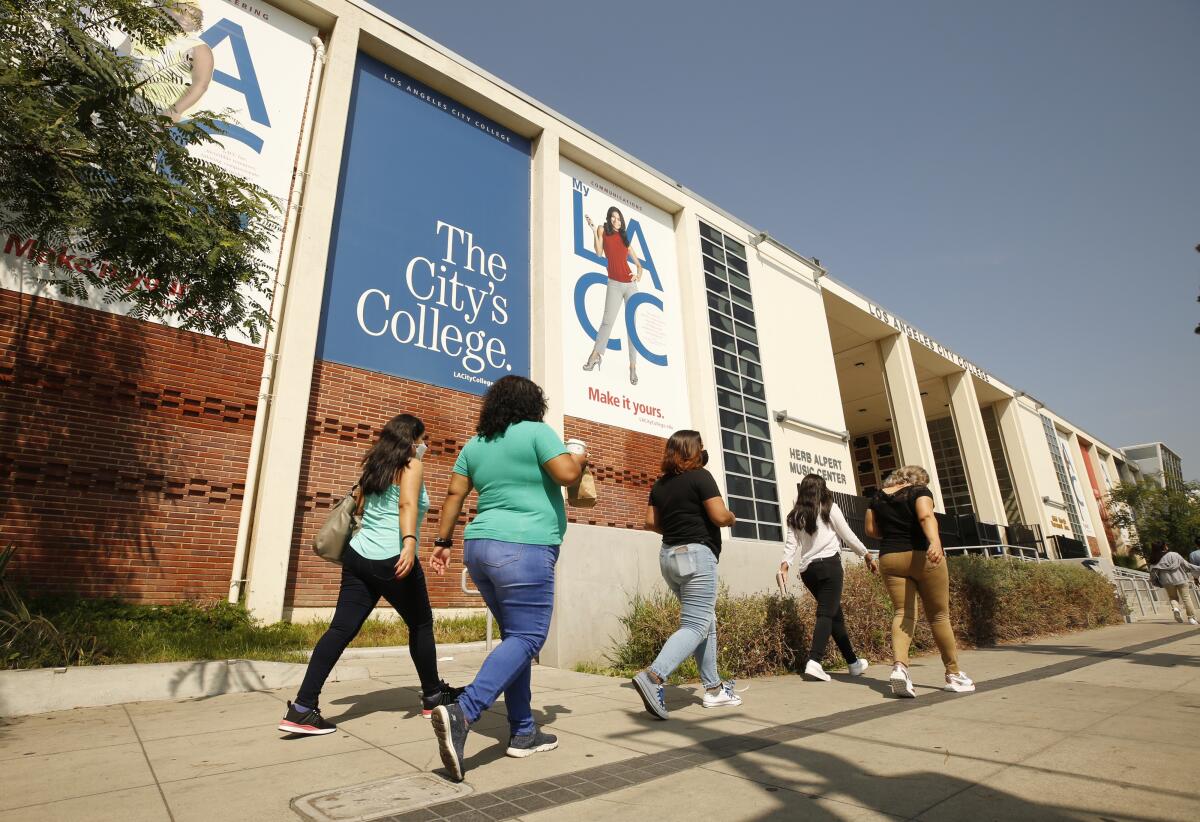UC will give a second chance to rejected California high school students

- Share via
The University of California, aiming to widen admission access for disadvantaged students, will give a second chance to thousands of rejected California high school applicants who had a qualifying 3.0 grade point average but failed to complete the required series of 15 college preparation courses.
But there’s a catch to receiving a guaranteed spot at the highly competitive universities: Students must first successfully complete their missing lower division and general education courses at a community college and earn the program’s required grades.
The proposed pilot program, presented Wednesday at the Board of Regents meeting in San Diego, is aimed at about 3,700 of the 10,000 California first-year UC applicants who did not meet the system’s first-year admission requirements — about half of whom were low-income, underrepresented students of color or the first in their families to attend college.
Beginning next year, such students who meet the pilot program’s requirements will receive a guaranteed spot at one of six UC campuses — Davis, Irvine, Merced, Riverside, Santa Barbara and Santa Cruz. They would still be eligible to apply to the three most popular campuses — UCLA, UC Berkeley and UC San Diego — though admission would not be guaranteed.
The program comes amid sharp declines in community college enrollments and concerns at UC and California State University about the diminished pipeline of transfer students to four-year campuses. The state’s fall 2021 undergraduate enrollment at all universities, private and public, dropped by nearly a quarter-million students when compared with pre-pandemic fall 2019 — a decline largely driven by a nearly 10% enrollment plunge at community colleges, according to a survey released this year by the National Student Clearinghouse.
At the Los Angeles Community College District, enrollment has dropped even more — 11% from fall 2020 to fall 2021 and 20% over the last two years, Chancellor Francisco Rodriguez told the board of trustees last fall. The community college district serves students who have been hit hard by the pandemic in Los Angeles County — parts of which have experienced high rates of COVID-19.
The pilot program could help turn that trend around, said Abeeha Hussain, a UCLA fourth-year student who transferred from Palomar College in San Marcos.
“This will convince so many more students to stay in school if they know that transferring into UC is actually a tangible reality,” Hussain said. “It will give so much more access to low-income students and others and also enrich the UC with more representation.”
Hussain said some of her friends did not complete UC’s required coursework in high school because “life got in the way.” One friend, she said, dropped out of school for a year when her mother died and did not complete the required four years of English.
In some cases, California schools do not offer all the required courses, which includes four years of English, three years of math, two years of science, history and a language other than English, one year of visual or performing arts and a year of electives. Among 3,700 California high schools, only 1,867 offered the full 15-course complement last year, according to data presented at the meeting Wednesday.
Regent Eloy Ortiz Oakley, former California Community Colleges chancellor who now heads the College Futures Foundation, said the pilot program could give a concrete path to success to underserved students who think that attending UC is an impossible dream.
“Being able to grab them, give them the opportunity to get into the UC and give them a road map for how to succeed would send a huge positive message to low-income communities and communities of color in California that UC is serious about finding talent in all places,” Oakley said.
UC was asked to set up the three-year program, which will launch in fall 2023, by the state Legislature and Gov. Gavin Newsom. The university system already offers a few other transfer guarantee programs between specific community colleges and UC campuses. But under the pilot program, UC will make the conditional offer soon after admission decisions are released in the spring to incentivize students who are otherwise rejected from their campuses of choice.
The program is also aimed at diversifying UC’s transfer student population and increasing the number of state community colleges from which the system’s nine undergraduate campuses draw applicants. Most students transfer to UC from only about 15 of the system’s 116 community colleges.
A key feature to helping the students succeed is far more hands-on academic support and advising. Students admitted into the dual admission program will be assigned a UC coordinator to help keep them on track and receive access to UC libraries, invitations to transfer student events at the UC campus of choice to start building ties, a preliminary estimate of expected financial aid and an application fee waiver. UC officials also hope to secure priority community college registration for students admitted to the program.
For some advocates, however, UC still has more work to do to open access to transfer students.
A report on transfer initiatives between the UC and California Community Colleges systems since 2018, presented to regents Wednesday, detailed several steps taken to open access and prepare more students to advance to a four-year university.
The number of state community college students who met transfer requirements — generally completion of 60 or more units with at least a 2.0 GPA and transfer-level math and English — increased from 72,936 to 105,343, or 44%, from 2011 to 2020.
But the growth has occurred unevenly across gender and race. The number of community college students who met transfer requirements grew by 143% among Latinos, 54% among Black students and 16% among Asians and stayed about the same among white students. It decreased among American Indian, Alaska Native and Native Hawaiian and Pacific Islander students. Many more women than men qualified to advance to a four-year university.
Although UC offers of admission increased by 15.6% from 2017 to 2021, the admission rate fell systemwide from 75.6% to 72.5% during that period. The most competitive campuses, such as UCLA and UC Berkeley, have far lower admission rates.
The report offered several recommendations to improve access and success for community college transfer students, including setting specific enrollment targets, streamlining transfer requirements and further research into obstacles and opportunities facing students.
But Audrey Dow of the Campaign for College Opportunity was underwhelmed. She said UC should commit to a systemwide transfer guarantee to qualified students rather than individual campuses — and take more action rather than continue to study the issue.
“Suggesting one solution is research is just pushing off the hard decisions,” she said.
More to Read
Sign up for Essential California
The most important California stories and recommendations in your inbox every morning.
You may occasionally receive promotional content from the Los Angeles Times.











